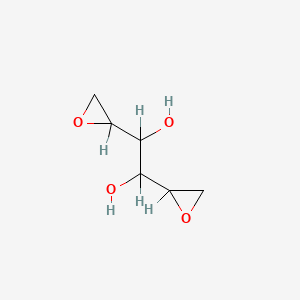
Synopsis
Synopsis
0
API Suppliers
0
USDMF
0
CEP/COS
0
JDMF
0
EU WC
0
KDMF
0
NDC API
0
VMF
0
Listed Suppliers
0
EDQM
0
USP
0
JP
0
Others
0
FDF Dossiers
0
FDA Orange Book

0
Europe

0
Canada

0
Australia

0
South Africa

0
Listed Dossiers
DRUG PRODUCT COMPOSITIONS
0
US Patents
0
US Exclusivities
0
Health Canada Patents
US Medicaid
NA
Annual Reports
NA
Regulatory FDF Prices
NA
0
API
0
FDF
0
Data Compilation #PharmaFlow
0
Stock Recap #PipelineProspector
0
Weekly News Recap #Phispers
0
News #PharmaBuzz


1. 1,2,5,6-dianhydrogalactitol
2. 1,2-5,6-dianhydrogalactitol
3. Dianhydrogalactitol
4. Diepoxydulcitol
5. Diepoxygalactitol
6. Nsc 132313
7. Nsc-132313
8. Nsc132313
1. 1,2:5,6-diepoxydulcitol
2. Dianhydromannitol
3. 23261-20-3
4. 1,2-bis(oxiran-2-yl)ethane-1,2-diol
5. Nsc 132313
6. 5,6-diepoxydulcitol
7. 1,2-5,6-dianhydro-dulcitol
8. 1,2:5,6-dianhydrodulcitol
9. Galactitol, 1,2:5,6-dianhydro-
10. Dianhydrodulcitol;dianhydrogalactitol
11. Nsc132313
12. 19895-66-0
13. Nsc-133129
14. 1,6-diepoxydulcitol
15. 1,6-dianhydrodulcitol
16. 1,6-dianhydromannitol
17. 1,6-dianhydrogalactitol
18. 1,6-diepoxy-d-mannitol
19. 1,6-dianhydro-d-mannitol
20. 1,2:5,6-dianhydrohexitol
21. 1,6-di-anhydro-d-mannitol
22. Galactitol,2:5,6-dianhydro-
23. Schembl8375579
24. D-mannitol,2:5,6-dianhydro-
25. Chembl1987719
26. Dtxsid60941768
27. Mannitol,2:5,6-dianhydro-, D-
28. Nsc133129
29. Akos025396866
30. Nci60_000711
31. Ft-0667810
32. 261d203
| Molecular Weight | 146.14 g/mol |
|---|---|
| Molecular Formula | C6H10O4 |
| XLogP3 | -1.3 |
| Hydrogen Bond Donor Count | 2 |
| Hydrogen Bond Acceptor Count | 4 |
| Rotatable Bond Count | 3 |
| Exact Mass | 146.05790880 g/mol |
| Monoisotopic Mass | 146.05790880 g/mol |
| Topological Polar Surface Area | 65.5 Ų |
| Heavy Atom Count | 10 |
| Formal Charge | 0 |
| Complexity | 122 |
| Isotope Atom Count | 0 |
| Defined Atom Stereocenter Count | 0 |
| Undefined Atom Stereocenter Count | 4 |
| Defined Bond Stereocenter Count | 0 |
| Undefined Bond Stereocenter Count | 0 |
| Covalently Bonded Unit Count | 1 |
Antineoplastic Agents, Alkylating
A class of drugs that differs from other alkylating agents used clinically in that they are monofunctional and thus unable to cross-link cellular macromolecules. Among their common properties are a requirement for metabolic activation to intermediates with antitumor efficacy and the presence in their chemical structures of N-methyl groups, that after metabolism, can covalently modify cellular DNA. The precise mechanisms by which each of these drugs acts to kill tumor cells are not completely understood. (From AMA, Drug Evaluations Annual, 1994, p2026) (See all compounds classified as Antineoplastic Agents, Alkylating.)
ABOUT THIS PAGE
66
PharmaCompass offers a list of Dianhydrogalactitol API manufacturers, exporters & distributors, which can be sorted by GMP, USDMF, JDMF, KDMF, CEP (COS), WC, Price,and more, enabling you to easily find the right Dianhydrogalactitol manufacturer or Dianhydrogalactitol supplier for your needs.
Send us enquiries for free, and we will assist you in establishing a direct connection with your preferred Dianhydrogalactitol manufacturer or Dianhydrogalactitol supplier.
PharmaCompass also assists you with knowing the Dianhydrogalactitol API Price utilized in the formulation of products. Dianhydrogalactitol API Price is not always fixed or binding as the Dianhydrogalactitol Price is obtained through a variety of data sources. The Dianhydrogalactitol Price can also vary due to multiple factors, including market conditions, regulatory modifications, or negotiated pricing deals.
A Dianhydrogalactitol manufacturer is defined as any person or entity involved in the manufacture, preparation, processing, compounding or propagation of Dianhydrogalactitol, including repackagers and relabelers. The FDA regulates Dianhydrogalactitol manufacturers to ensure that their products comply with relevant laws and regulations and are safe and effective to use. Dianhydrogalactitol API Manufacturers are required to adhere to Good Manufacturing Practices (GMP) to ensure that their products are consistently manufactured to meet established quality criteria.
A Dianhydrogalactitol supplier is an individual or a company that provides Dianhydrogalactitol active pharmaceutical ingredient (API) or Dianhydrogalactitol finished formulations upon request. The Dianhydrogalactitol suppliers may include Dianhydrogalactitol API manufacturers, exporters, distributors and traders.
Dianhydrogalactitol Active pharmaceutical ingredient (API) is produced in GMP-certified manufacturing facility.
GMP stands for Good Manufacturing Practices, which is a system used in the pharmaceutical industry to make sure that goods are regularly produced and monitored in accordance with quality standards. The FDA’s current Good Manufacturing Practices requirements are referred to as cGMP or current GMP which indicates that the company follows the most recent GMP specifications. The World Health Organization (WHO) has its own set of GMP guidelines, called the WHO GMP. Different countries can also set their own guidelines for GMP like China (Chinese GMP) or the EU (EU GMP).
PharmaCompass offers a list of Dianhydrogalactitol GMP manufacturers, exporters & distributors, which can be sorted by USDMF, JDMF, KDMF, CEP (COS), WC, API price, and more, enabling you to easily find the right Dianhydrogalactitol GMP manufacturer or Dianhydrogalactitol GMP API supplier for your needs.
A Dianhydrogalactitol CoA (Certificate of Analysis) is a formal document that attests to Dianhydrogalactitol's compliance with Dianhydrogalactitol specifications and serves as a tool for batch-level quality control.
Dianhydrogalactitol CoA mostly includes findings from lab analyses of a specific batch. For each Dianhydrogalactitol CoA document that a company creates, the USFDA specifies specific requirements, such as supplier information, material identification, transportation data, evidence of conformity and signature data.
Dianhydrogalactitol may be tested according to a variety of international standards, such as European Pharmacopoeia (Dianhydrogalactitol EP), Dianhydrogalactitol JP (Japanese Pharmacopeia) and the US Pharmacopoeia (Dianhydrogalactitol USP).
